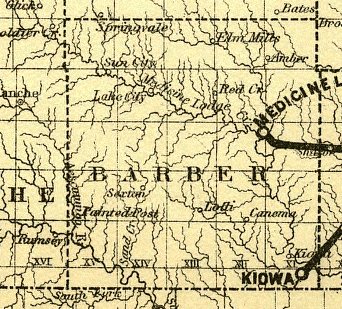
Barber County Kansas

 |
Barber County Kansas |
 |

1886 map of Barber County, Kansas
- "Hebron, also known as New Jerusalem, was in Barber County, and at its peak, 1885-86, may have had as many as 200 residents including Hungarian, Austrian and German Jews as well as Russian Jews. Gilead, begun in 1886, was a Rumanian Jewish community in Comanche County only a few miles southwest of Hebron." -- Sod Jerusalems: Jewish Agricultural Communities in Frontier Kansas, by Lloyd Davis Harris.
- "They found suitable land about 20 to 25 miles southwest of Medicine Lodge, a few miles south and east of the village of Deerhead. The town of Aetna, and the settlements of Canema (Cumminsford-Last Chance), Lodi and Sexton were also nearby. At its peak, in 1886-87, the Hebron colony was scattered throughout an area of 35 to 40 square miles with settlers on virtually every section. It was known as the Hebron colony to its Eastern sponsors, the Montefiore Agricultural Aid Society, but when its Gentile Barber County neighbors saw its sod synagogue and heard the prayers of its people they dubbed it New Jerusalem. Within a year the colony had 30 resident families, about 150 people. After a year and a half, there were 50 to 60 families; at two years there were 80 families, at least 300 people. "Russians, Poles, Rumanians and Hungarians were attracted from all sides to Southern Kansas and the extensive colony of Hebron," Michael Heilprin wrote in the April 8, 1887 issue of the American Hebrew. Indeed, after a year and a half, its sponsoring Montefiore society started another colony, Gilead, about 10 miles southwest of Hebron in Comanche County for more Rumanian refugees. The colonies were close enough they were almost one. -- Hebron and Gilead: Gyp Hills Jerusalums, Chapter IX, Sod Jerusalems: Jewish Agricultural Communities in Frontier Kansas, by Lloyd Davis Harris.
- New Jerusalem: East of Deerhead. -- "In 1886 over 50 Jewish families came to Barber County to set up a colony. They may have had plans to build a town here, but nothing developed. Life on the plains was hard, and by 1893 most of the families had left. Some traces of their dugouts and sod homes remain on Lloyd Sutton's farm..." -- Touring Barber & Harper Counties by Robert Collins.
Thanks to Kim Fowles for the above information.